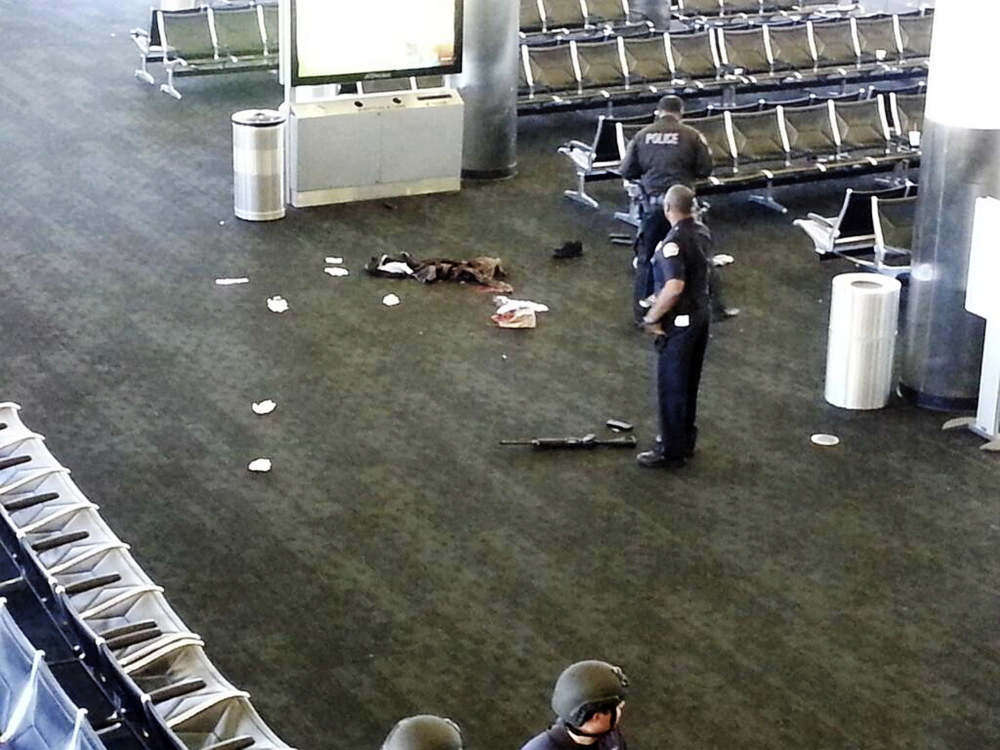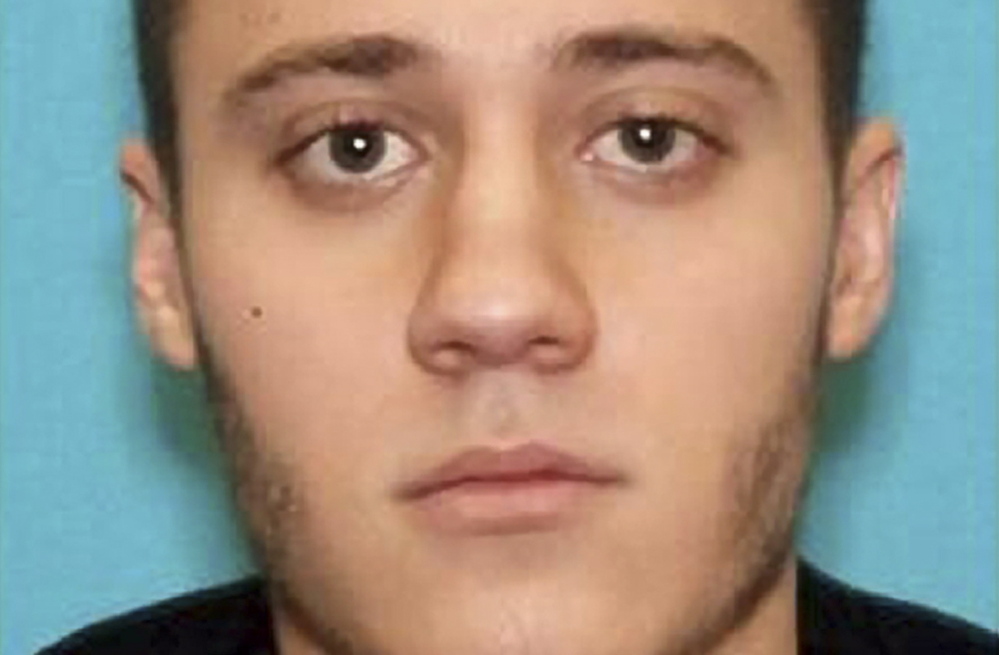LOS ANGELES — A report on the emergency response to a shooting last year at Los Angeles International Airport, which left a security screener dead, cites serious shortcomings in communication between agencies that left major commanders in the dark and a long lag in establishing a coordinated response.
An early copy of the report to be presented Tuesday to airport commissioners was obtained by The Associated Press. Nothing has been blacked out for security reasons in the single report that will be presented, airport spokeswoman Nancy Castles said.
Before the presentation, Mayor Eric Garcetti planned to hold a news conference highlighting the findings.
The lengthy report cites the “heroism” of officers who shot and took suspect Paul Ciancia into custody after he’d killed a Transportation Security Administration officer and injured three people on Nov. 1.
But it details lapses in coordination and technology between police and fire departments, which set up multiple command posts at different locations that didn’t unify for 45 minutes. The first meeting among commanders didn’t occur until more than 1 1/2 hours after the shooting began.
The report says police and fire officials were hindered by incompatible radio systems that prevented airport police from communicating. Meanwhile, senior police and fire commanders arriving on scene had no idea where to go or what the others were doing. There was nearly no communication between the command post officials and those in the airport’s emergency operations center, which the report described as being staffed by untrained mid-level managers.
Fire officials concerned by how close the incident command post was to the initial shooting site originally set up their own command post, which hampered the ability to coordinate with law enforcement and to get victims out of the terminal. Airport police had to send two teams of marksmen on top of parking structures to protect the command post amid initial worries of additional shooters.
Authorities say Ciancia, 24, targeted TSA officers in his attack. The Pennsville, N.J., native who moved to Los Angeles two years earlier, has pleaded not guilty to 11 federal charges, including murder of a federal officer.
The report cites a number of lessons learned, including some 50 recommendations, and ominously warns: “Had the attacker not been highly selective in his targets, and/or had there been multiple attackers with weapons of greater lethality, the outcome might have been far different.”
Much of the review confirms earlier reports by the AP, including that a TSA supervisor picked up a red phone immediately after the first shots were fired and the gunman hastily fled. The report says the airport police dispatcher “only heard the sounds of shouting and gunshots. With no caller identification for a call from a Red Phone, and no one on the other end of the line, it was not initially known from where the call originated.”
Technical malfunctions were discovered at the Terminal 3 checkpoint and an airport-wide audit of red phones and panic buttons found some of those devices weren’t working properly. The report calls for updates to the airport’s emergency “red phones” and improvements to how airport police receive 911 calls as well as to security cameras.
The broad review of the emergency response conducted by airport staff and an outside contractor included interviews with airport staff, law enforcement and first responders, reviews of camera footage, dispatch logs and 911 calls.
There is no mention of podium officers in the report or the airport’s change in policy months before the shooting that allowed the formerly stationary podium officers to roam, provided they could respond to an emergency at the screening station within three minutes. Nor is there mention of the two airport police officers assigned to Terminal 3 who were out of position without notifying dispatchers as required when the shooting erupted.
The heads of the airport police union and the Los Angeles Police Department union have both called for reinstating podium officers to deter attacks and to protect screening stations where unarmed TSA officers work.
The report recommends that airport police test their random security deployments to determine flaws after it was determined that Ciancia may have passed through an airport police checkpoint but evidently wasn’t deterred or stopped.
It includes many details on communication problems, attributing a large portion to incompatible radio systems. The airport spent $5.4 million in 2011 on a new high-tech radio system, which often proved useless in communicating with the more than 20 agencies that responded.
“Aside from the expected initial confusion that typifies such events, the establishment of unified command and build-out of the incident command post was delayed, non-interoperable radio systems caused gaps in cross-agency coordination, and mutual-aid response, though substantial, needed better resource management,” the report states.
A flood of responders made it difficult to track resources and organize their deployment. And the responders left their vehicles in airport roadways, requiring them to be towed.
Because officers from other jurisdictions working LAX perimeter checkpoints had not been given directions, they turned away many responders who had to find an escort in, including members of the Department of Disabilities, the Red Cross, TSA security officers, pilots and flight attendants, aircraft mechanics, ground crews, service workers. Even the airport executive director and head of media relations weren’t allowed in for a time.
Recommendations include improving the public announcement system to allow central control throughout the airport and increased training for the entire airport community and other agencies involved in responding to such emergencies. The report also calls for training airport police in tactical medicine so they can help the injured before paramedics arrive.
More than 23,000 travelers were evacuated or held in areas with little information during the airport’s roughly six-hour shutdown. The report says the airport has since created emergency teams to provide information to travelers in such situations after realizing its evacuation procedures were lacking.
Los Angeles World Airports, which operates LAX and two other airports, spends $125 million on security annually, according to the report.
It is highly critical of the Los Angeles World Airports’ emergency management program, which it says is “not well-defined or widely understood across the agency, or perhaps even respected by the stakeholders it must be engaged with and from whom it must win support and cooperation.”
It adds that the airport operator’s emergency management division “does not appear to be appropriately organized, sufficiently staffed, or adequately resourced to fulfill the responsibilities associated with administering a comprehensive emergency management program at a major international airport.”
The airport had a draft plan to deal with an active shooter that was prepared in March 2013 but wasn’t put out because of an inability to reach a consensus among officials on the airport’s emergency management committee.
The airport has hired an outside contractor to work on an emergency plan and program since early 2012; that process, which was extended for 18 months last summer, is ongoing.
The report points to six different risk assessments conducted over the last 10 years, including by federal officials, the airport, a former mayor’s special panel and a nonprofit research organization. It says there is no central integrated tracking system that looks at the resolution of problems identified by such reports.
“It is possible that gaps in capabilities evident during the incident on November 1, 2013 could have been identified and resolved through a more integrated risk assessment and planning process,” the report states.
Send questions/comments to the editors.




Success. Please wait for the page to reload. If the page does not reload within 5 seconds, please refresh the page.
Enter your email and password to access comments.
Hi, to comment on stories you must . This profile is in addition to your subscription and website login.
Already have a commenting profile? .
Invalid username/password.
Please check your email to confirm and complete your registration.
Only subscribers are eligible to post comments. Please subscribe or login first for digital access. Here’s why.
Use the form below to reset your password. When you've submitted your account email, we will send an email with a reset code.